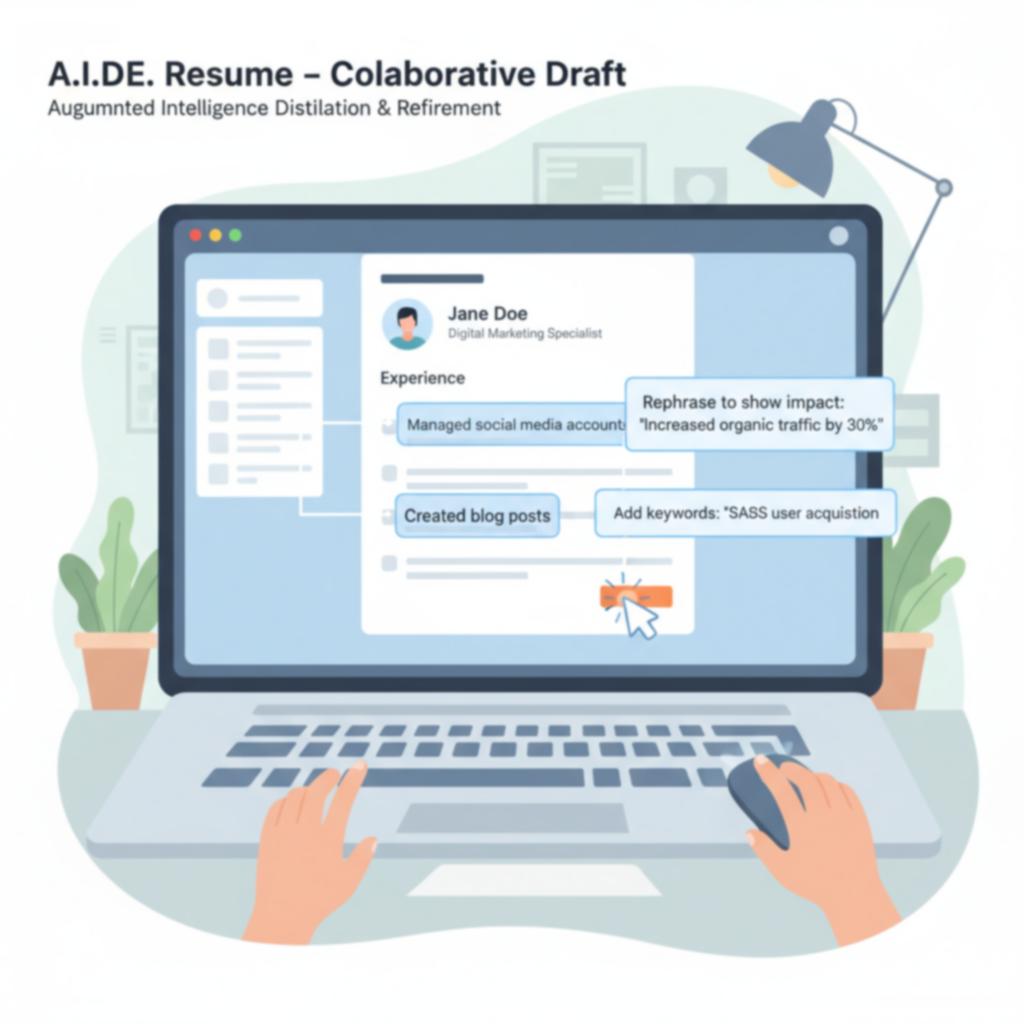Staring at a blinking cursor on a blank document, trying to perfectly summarize your entire career, is nobody's idea of fun. You know your experience is valuable, but translating it into the right words—words that impress both a recruiter and a robot—feels impossible. What if you could skip the agony and get a powerful, tailored resume draft in minutes? That's exactly what AI resume builders promise.
Key Takeaways: Your AI Advantage
- Beat the Blank Page: Generate a strong first draft instantly, eliminating writer's block and saving you hours of work.
- Optimize for Robots (ATS): AI tools are designed to analyze job descriptions and suggest keywords that get your resume past Applicant Tracking Systems.
- Quantify Your Wins: AI can help rephrase your duties into achievements, turning a simple task list into a compelling story of your impact.
- Tailor with Speed: Quickly customize your resume for every single job application, dramatically increasing your callback rate without the manual effort.
- Stay Professional & Consistent: Choose from proven templates and maintain a clean, professional format that hiring managers love.

How Do You Pick the Right AI Resume Sidekick?
Not all AI tools are created equal. The right one for you depends on your specific needs. Before you commit, audit your options based on a few key factors. Don't just pick the first one you see; find the one that fits your workflow.
Core Features to Look For:
- ATS-Friendliness: The tool must generate resumes that are easily parsed by Applicant Tracking Systems. Look for clean, single-column templates and standard fonts.
- Ease of Use: The interface should be intuitive. You're here to save time, not to learn a complex new piece of software.
- Customization & Editing: Good AI provides a great starting point, but you need the ability to easily edit, rephrase, and inject your own voice. A rigid tool is a useless one.
- Job Description Targeting: The best tools allow you to paste in a job description and get immediate feedback on how well your resume matches it.
A Quick Look at Top AI Resume Tools
The market is full of options, but a few consistently stand out. Here’s a quick comparison to help you triage the choices.
For a Feature-Packed Experience: Kickresume
Kickresume is often praised for its all-in-one approach. It packs in an AI writer, a wide variety of templates, and even AI-powered cover letter generation. It's a solid choice if you want one tool to handle multiple parts of your application.
For Keyword-Focused Targeting: Rezi
Rezi's big selling point is its intense focus on ATS optimization. It scores your resume against a specific job description in real-time and highlights keywords you're missing. It's built for job seekers who are applying to high-volume roles at large companies.
For an Integrated Career Platform: Livesume
While standalone builders are useful, the real goal is to build a cohesive professional brand. With Livesume's AI resume builder, you're not just creating a static document. You’re building the foundation for your dynamic Live Resume and a more comprehensive digital portfolio. It’s about connecting your resume to your entire professional story.
Ready to Build a Better Resume?
Don't just write a resume—build your professional brand. Try Livesume’s AI-powered tools to create a resume that opens doors.
Start Building for Free
The A.I.D.E. Framework: Your 4-Step AI Resume Workflow
Using AI isn't about hitting a button and sending the result. It's a partnership. To get the best results, you need a system. Follow the A.I.D.E. framework to turn raw AI output into a job-winning document.

Step 1: Assemble Your Core Data
Give the AI good ingredients. Before you even start, gather your job history, key projects, and any metrics you can remember. The more detailed your input, the more targeted the AI's output will be. Don't make it guess.
Step 2: Ideate & Generate
This is where the AI shines. Feed it your core data and the target job description. Let it generate multiple versions of your summary and bullet points. Your goal here isn't perfection; it's to create a pool of strong options to choose from.
Here’s a quick before-and-after transformation:
- Before: "Wrote blog posts for the company website."
- AI-Assisted After: "Authored and published 15+ SEO-optimized articles per month, increasing organic blog traffic by 30% in six months."
Step 3: Distill & Humanize
Now, you take over. The AI is a great co-pilot, but you're the pilot. Review the generated text. Does it sound like you? Is it accurate? Consolidate the best parts, fix any awkward phrasing, and add your unique professional voice. This is the most critical step.
Another small shift can make a huge difference in your summary:
- Before: "An experienced marketing manager looking for a new role."
- AI-Assisted After: "Data-driven Marketing Manager with 8+ years of experience scaling SaaS user acquisition and reducing churn through targeted lifecycle campaigns."
Step 4: Evaluate Against the Target
Finally, do one last check. Put your edited resume side-by-side with the job description. Does it speak directly to the company's needs? Every bullet point should answer an implicit question the hiring manager has. If it doesn't, cut it or revise it.
Your AI Resume Questions, Answered (FAQ)
Will ATS reject an AI-written resume?
No, not if it's done right. ATS software scans for keywords, formatting, and structure, not writing style. As long as the AI builder produces a clean, well-formatted document, the ATS won't know the difference. The key is choosing a tool with ATS-friendly templates.
Is using an AI resume builder cheating?
Not at all. Think of it like using a calculator for math or a spell-checker for writing. It's a tool to make your work more efficient and effective. You are still providing the experience and expertise; the AI is just helping you articulate it better.
How much should I edit the AI's output?
A lot. A good rule of thumb is the 80/20 rule: use the AI for 80% of the initial drafting and keyword optimization, but spend the last 20% of your time on human-centric editing, proofreading, and personalization.
Can AI help with cover letters and other application materials?
Yes, many advanced platforms, including tools within our Marketing Suite, can help generate tailored cover letters, outreach emails, and even portfolio descriptions. The same principle applies: use it as a starting point, then add your personal touch.
What's the biggest mistake people make with AI resume tools?
Accepting the first draft without editing. AI can sometimes exaggerate, use generic corporate jargon, or misinterpret your input. Blindly copying and pasting is a recipe for a resume that sounds robotic and inauthentic. Always, always review and refine.
Turn Your AI Draft Into a Final Offer
An AI resume builder is an incredible tool for overcoming the initial hurdles of resume writing. It can help you save time, optimize for automated screeners, and frame your accomplishments in a more powerful way.
But remember, the final document represents you. Use the A.I.D.E. framework to guide your process:
- Assemble your career facts.
- Ideate with the AI to generate strong drafts.
- Distill and inject your human voice.
- Evaluate the final product against your target job.
By combining smart technology with your unique experience and oversight, you create more than just a resume—you create a powerful first impression that gets you in the door. Explore our blog for more career-building tips.